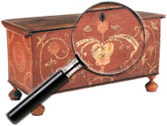|
|
Carol Brooks MacNeil (American, 1871 to 1944)
Carol Brooks MacNeil studied sculpture at the Art Institute of Chicago and assisted Lorado Taft in creating statues for the 1893 World’s Exposition. She continued her studies in Paris under the famous sculptor Frederick MacMonnies and, in 1894, married sculptor Herman A. MacNeil. She exhibited and won awards at later expositions.
Information courtesy of New Orleans Auction, July 2007.
Jules Felix Coutan (French, 1848 to 1939)
Known for his classically inspired allegorical works, Jules Felix Coutan had a long and successful career as a sculptor and teacher. He studied under Pierre-Jules Cavelier (1814 to 1894) at the Ecole des Beaux-Arts in Paris and won the prestigious Prix de Rome in 1871. He debuted in the Salon of 1876, where he won the gold medal. In 1881, Coutan’s proposed plans for a commemorative monument [...] Click here to continue reading.
Anna Coleman Watts Ladd (American, 1878 to 1939)
Anna Coleman Watts Ladd was born in Bryn Mawr, Pennsylvania, She studied in Philadelphia at the Pennsylvania Academy of the Fine Arts with Charles Grafly and in France with Auguste Rodin. She actively exhibited on both sides of the Atlantic, garnering recognition for her portrait busts, relief panels and soldiers monuments. In France during World War I, she made life masks of the disfigured soldiers she [...] Click here to continue reading.
Harriet Whitney Frishmuth (American, 1880 to 1980)
Born in Philadelphia in 1880, Harriet Whitney Frishmuth was one of the most esteemed and ground breaking female sculptors of her time. In her youth, she lived and studied in Switzerland, France, and Germany. At the age of 19, at which time she moved to Paris and briefly studied with Auguste Rodin. Following her return to the United States, Frishmuth attended the Art Students League of New [...] Click here to continue reading.
Thomas Ball (American, 1819 to 1911)
Thomas Ball, born in Massachusetts the son of a house and sign painter, worked at Moses Kimball’s Boston Museum and Fine Arts Gallery, where he also cut silhouettes. Beginning in 1837, he progressed to miniature, and then life-sized, portraits. His work was exhibited at the Boston Athenaeum, the American Art Union, and the Apollo Art Association. Beginning about 1851, however, Ball focused on sculpture, his most famous being [...] Click here to continue reading.
Thomas Ball (American, 1819 to 1911)
Thomas Ball, born in Massachusetts the son of a house and sign painter, worked at Moses Kimball’s Boston Museum and Fine Arts Gallery, where he also cut silhouettes. Beginning in 1837, he progressed to miniature, and then life-sized, portraits. His work was exhibited at the Boston Athenaeum, the American Art Union, and the Apollo Art Association. Beginning about 1851, however, Ball focused on sculpture, his most famous being [...] Click here to continue reading.
Thomas Ball (American, 1819 to 1911)
Thomas Ball, born in Massachusetts the son of a house and sign painter, worked at Moses Kimball’s Boston Museum and Fine Arts Gallery, where he also cut silhouettes. Beginning in 1837, he progressed to miniature, and then life-sized, portraits. His work was exhibited at the Boston Athenaeum, the American Art Union, and the Apollo Art Association. Beginning about 1851, however, Ball focused on sculpture, his most famous being [...] Click here to continue reading.
Thomas Ball (American, 1819 to 1911)
Thomas Ball, born in Massachusetts the son of a house and sign painter, worked at Moses Kimball’s Boston Museum and Fine Arts Gallery, where he also cut silhouettes. Beginning in 1837, he progressed to miniature, and then life-sized, portraits. His work was exhibited at the Boston Athenaeum, the American Art Union, and the Apollo Art Association. Beginning about 1851, however, Ball focused on sculpture, his most famous being [...] Click here to continue reading.
Thomas Ball (American, 1819 to 1911)
Thomas Ball, born in Massachusetts the son of a house and sign painter, worked at Moses Kimball’s Boston Museum and Fine Arts Gallery, where he also cut silhouettes. Beginning in 1837, he progressed to miniature, and then life-sized, portraits. His work was exhibited at the Boston Athenaeum, the American Art Union, and the Apollo Art Association. Beginning about 1851, however, Ball focused on sculpture, his most famous being [...] Click here to continue reading.
Alfonso A. Ossorio (American, 1916 to 1990)
Alfonso Ossorio was born in Manila in 1916, but moved to the United States as an adolescent. He studied both at Harvard University and the Rhode Island School of Design. Greatly influenced by Jean Dubuffet and Jackson Pollock, Ossorio’s work involves elements of Surrealism, Abstract Expressionism, and Art Brut. Seeking to develop a visual language through connections with innocence and raw emotions, his work rejects descriptive and [...] Click here to continue reading.
|
Recent Articles
- Charles Alfred Meurer – American Artist & Tromp L’Oeil Artist
- Sendak, Maurice – American Artist & Writer
- Godie, Lee – American Artist
- Davis, Vestie – American Artist
- Bartlett, Morton – American Artist
- Mackintosh, Dwight – American Artist
- Evans, Minnie Jones – African-American Artist
- Mumma, Ed (Mr. Eddy) – American Artist
- Nice, Don – American Artist
- Savitsky, John (Jack) – American Artist
- Gordon, Harold Theodore (Ted) – American Artist
- Dial, Thornton – African-American Artist
- Doyle Sam – American Artist
- Johnson, Lester Frederick – American Artist
- Finster, Howard – American Artist
|
|
